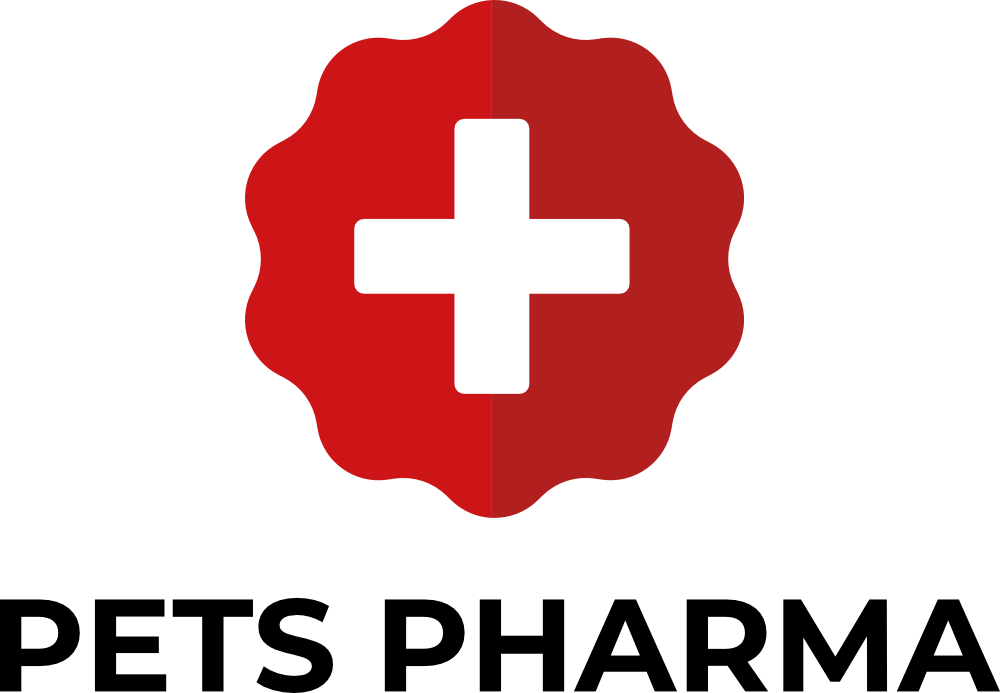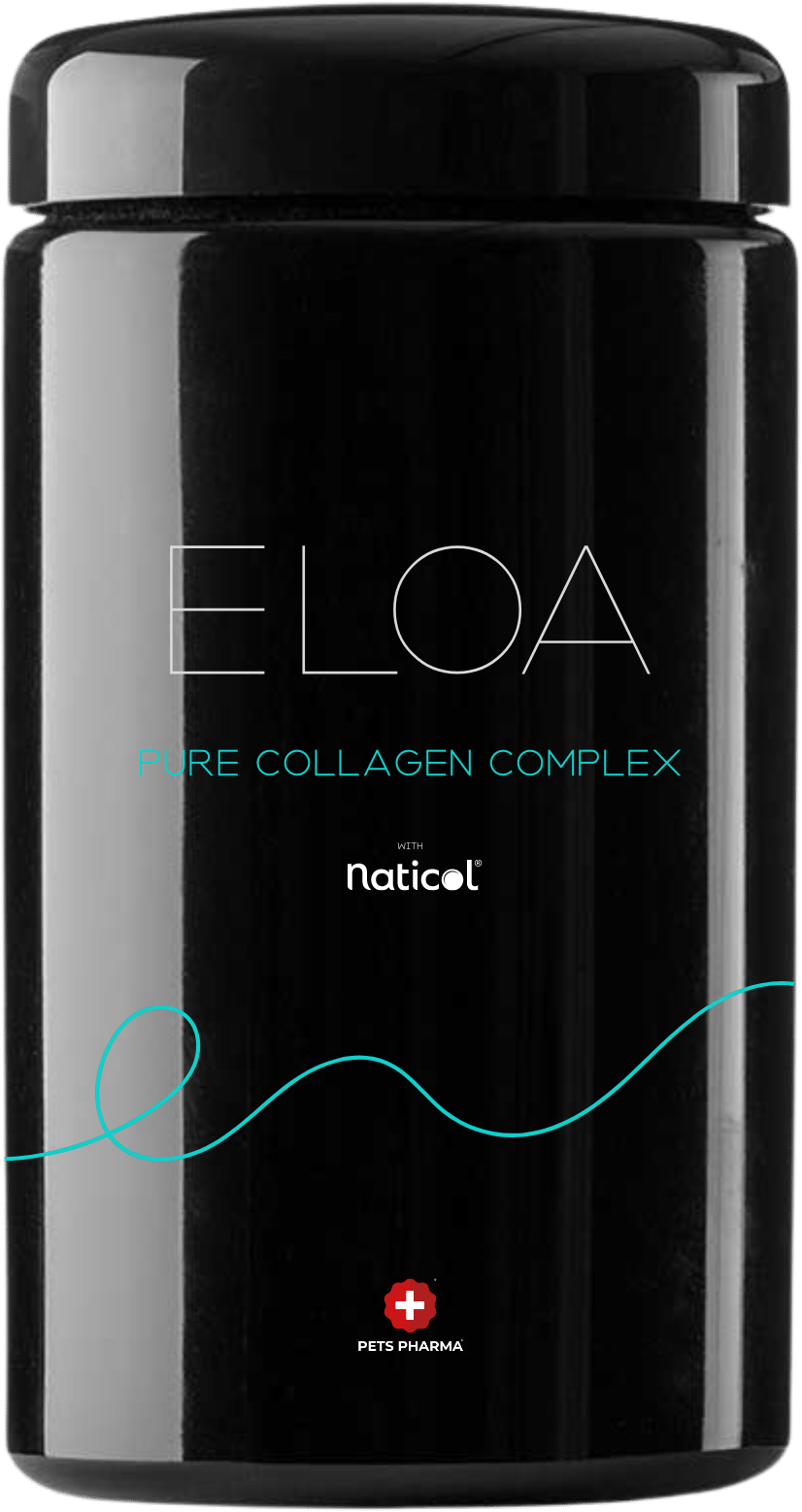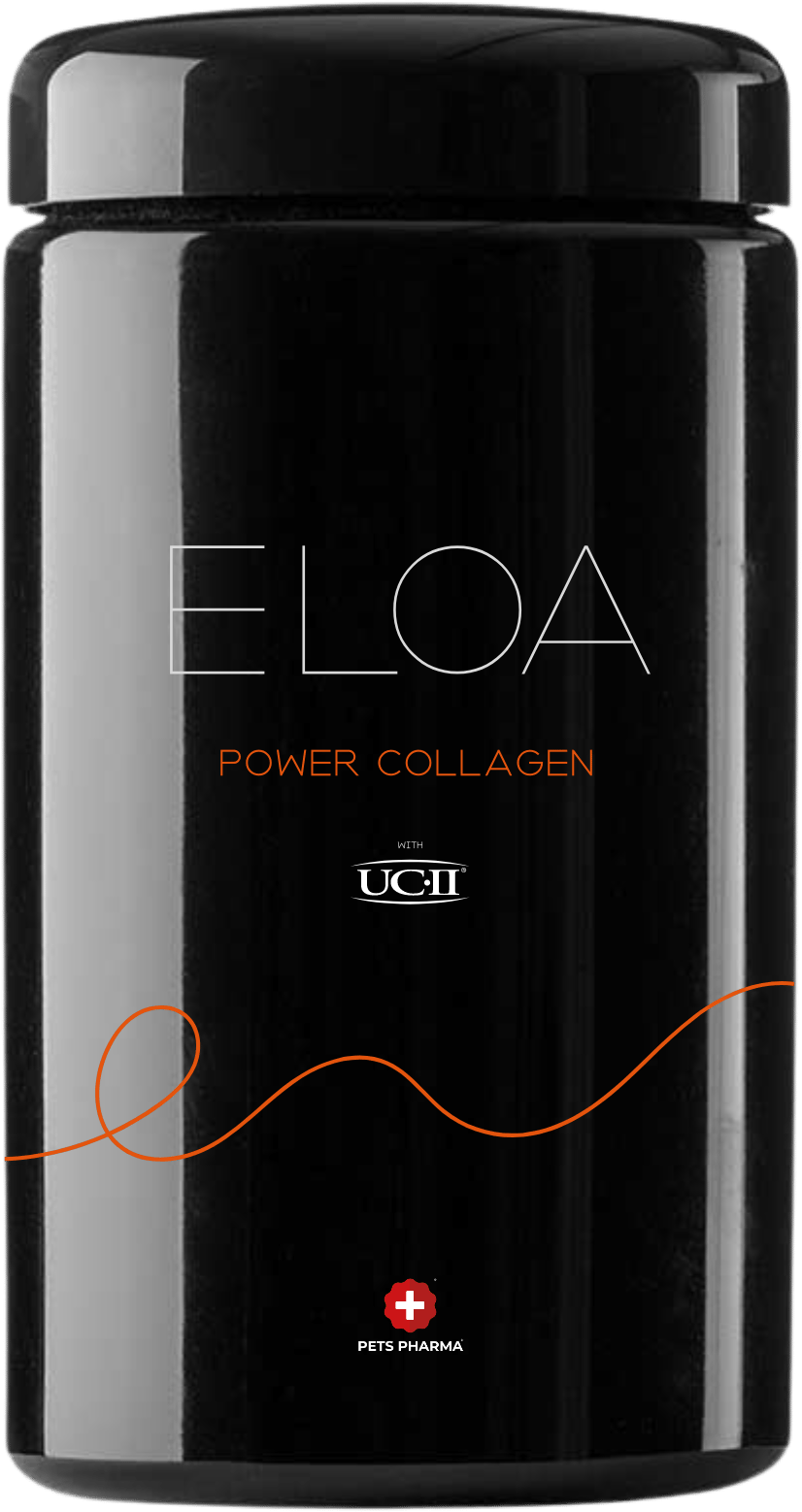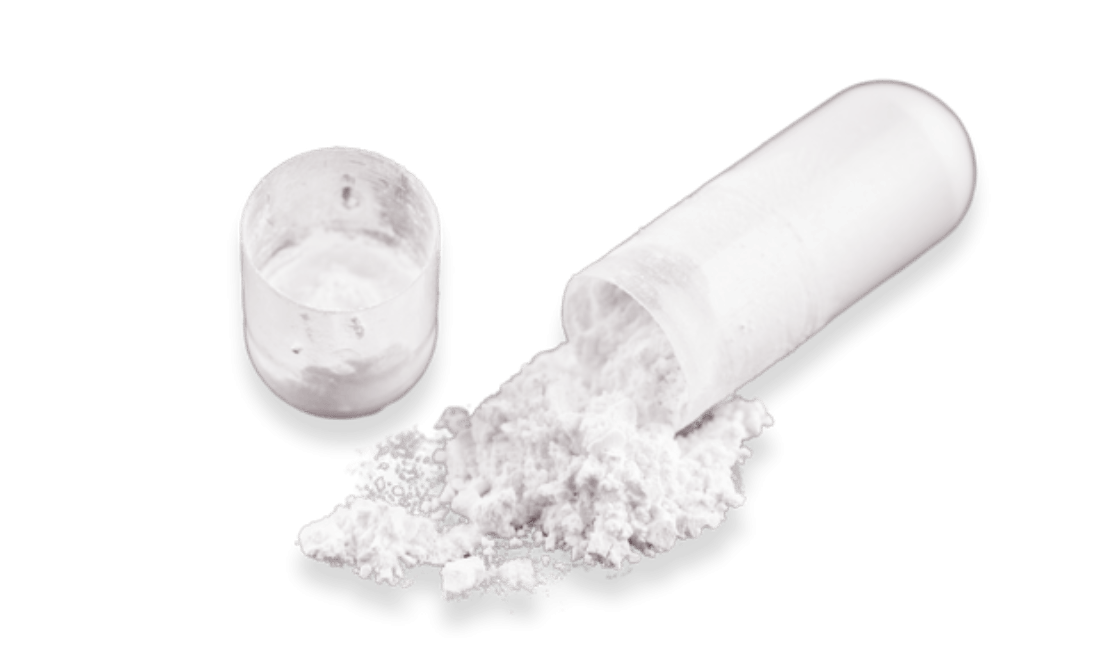Hip & Joint
Hip &Joint is a complex preparation supporting the proper functioning of the musculoskeletal system based on ingredients with scientifically proven effects. It combines as many as 8 ingredients (including patented, non-denatured collagen type II - UC-II® and omega-3 fatty acids) capable of reducing inflammation and swelling in the joints, providing substances necessary for the regeneration of damaged cartilage, reducing pain accompanying orthopaedic complaints and enabling sick dogs to undertake greater physical activity. ELOA Hip & Joint is particularly recommended for incipient or advanced diseases of the musculoskeletal system, as well as for dogs at high risk of developing such diseases.
UC-II® un-denatured type II collagen
It stimulates the body to increase the production of type II collagen and supports the regeneration of joint cartilage.
Omega-3 fatty acids
They provide the substances necessary for the regeneration of damaged cartilage.
Chondroitin, Glucosamine and MSM
Reduce the symptoms of osteoarthritis by reducing pain and swelling.
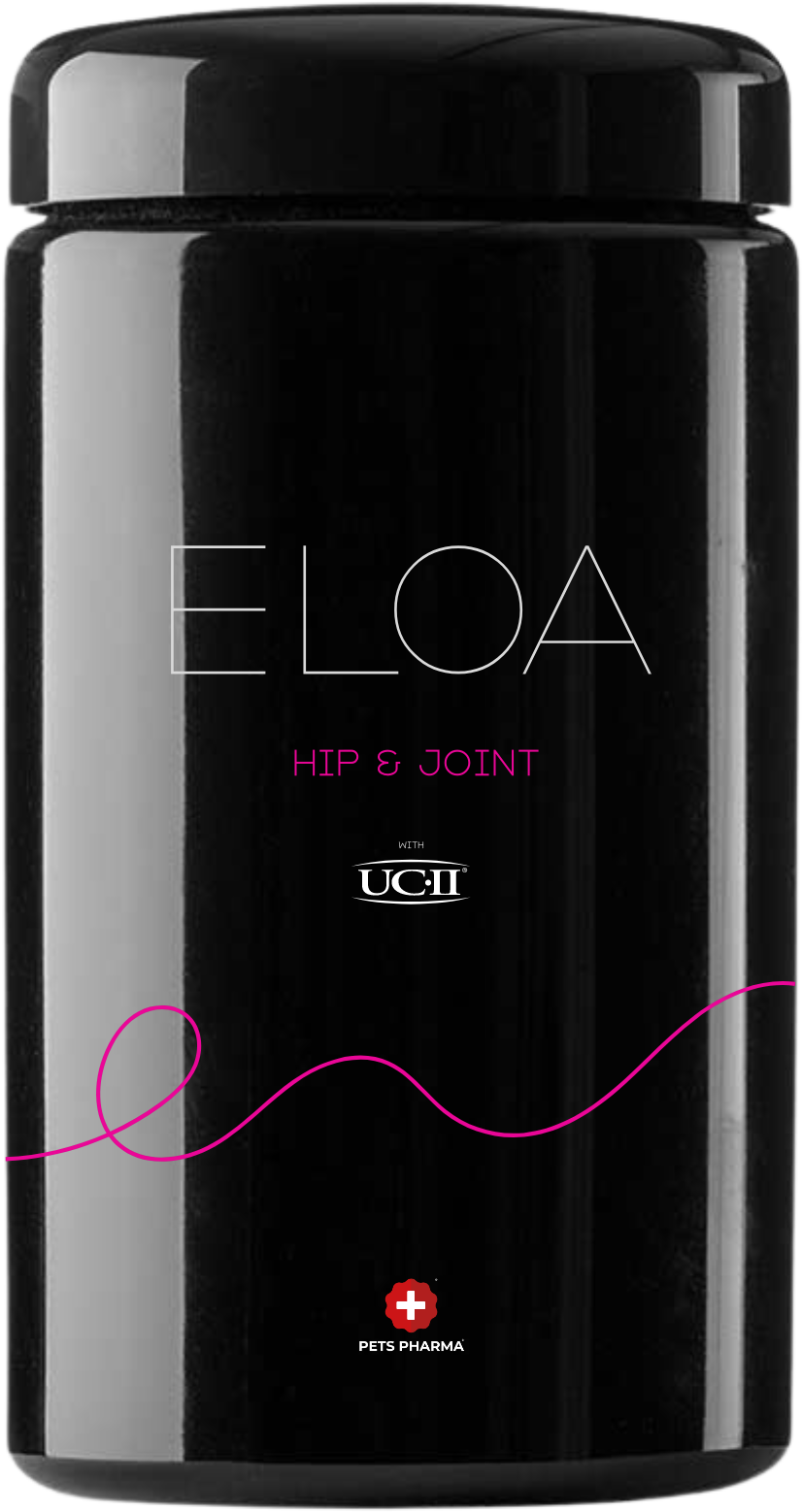
Boswellia serrata
It has anti-rheumatic and anti-inflammatory properties.
Hyaluronic acid
It reduces swelling in the joints, relieves pain and promotes the nutrition of joint structures.
Hydrolysed collagen
Supports natural joint regeneration and stimulates bone mineralisation.
UC-II® un-denatured type II collagen
It stimulates the body to increase the production of type II collagen and supports the regeneration of joint cartilage.
Omega-3 fatty acids
They provide the substances necessary for the regeneration of damaged cartilage.
Chondroitin, Glucosamine and MSM
Reduce the symptoms of osteoarthritis by reducing pain and swelling.
Boswellia serrata
It has anti-rheumatic and anti-inflammatory properties.
Hyaluronic acid
It reduces swelling in the joints, relieves pain and promotes the nutrition of joint structures.
Hydrolysed collagen
Supports natural joint regeneration and stimulates bone mineralisation.
Subscription purchase up to -50% off
- The longer you use, the less you pay
- With each renewal you receive an additional 5% discount
- You have ability to modify or cancel at any time
53.99 + 50.99 EUR 2 x 59.99 EUR
Discount grows with next renewal
One-time purchase without subscription
59.99 EUR
Relieves symptoms of musculoskeletal complaints and other cartilaginous structures
Enables sick dogs to undertake more physical activity
Provides substances necessary for the regeneration of damaged cartilage and reduces inflammation and swelling
Recommendations for use Hip & Joint
The product is particularly recommended for dogs:
- those suffering from osteoarthritis, spondylosis of the spine, hip or elbow dysplasia,
- requiring rehabilitation due to orthopaedic disease,
- displaying symptoms such as lameness, reluctance to engage in physical activity or difficulty in rising from bed,
- during recovery from fractures and orthopaedic surgery.
The best effects of supplementation can be achieved by increasing the daily dose of pure collagen by simultaneous use with Pure Collagen Complex.

Formula
DEVELOPED BY AN EXPERT

The use of collagen peptides of different molecular weights allows for the multi-directional action of the product:
- 2 kDa – has a positive effect on skin hydration and elasticity, stimulates the synthesis of collagen, proteoglycans and elastin in tendons and ligaments,
- 3 kDa – supports natural joint regeneration and mobility,
- 5 kDa – stimulates bone matrix synthesis and bone mineralisation.
Fish oil is a source of unsaturated fatty acids from the omega-3 family: EPA and DHA, the supplementation of which has a positive effect on the joints, as well as reducing lameness, improving joint mobility and enabling dogs to undertake more physical activity.
Methylsunphonylmethane (MSM), Chondroitin and Glucosamine help to significantly reduce the symptoms of osteoarthritis by reducing pain and swelling associated with inflammation.
Ekstrakt z Boswellia serrata znany jest z właściwości przeciwreumatycznych i przeciwzapalnych, może on stanowić bezpieczną alternatywę dla niesterydowych leków przeciwzapalnych służących do ograniczania dolegliwości związanych ze stawami.
Ingredients
UC-II® un-denatured type II collagen
Type II collagen is the collagen found primarily in articular cartilage. It is the main component of the intercellular substance and is one of the basic components of articular cartilage. UC-II® is a patented, non-denatured type II collagen produced from chicken bridges.
Non-denatured type II collagen provides a source of antigens that can react with immune cells and increase the production of anti-inflammatory factors, which reduces inflammation within the joints. It also stimulates the body to increase the production of type II collagen and promotes joint cartilage regeneration (1).
Studies in dogs show that supplementation with UC-II® for 90 days significantly reduces symptoms of osteoarthritis, reducing pain and lameness and allowing dogs to be more physically active (2). Supplementation of type II collagen in combination with glucosamine and chondroitin for as little as 30 days has also been shown to provide dogs with significant relief from joint pain (3). Type II collagen supplements are also recommended for dogs following surgery for a ruptured cruciate ligament, as they can speed up recovery (4).
- Bagchi, D., Misner, B., Bagchi, M., Kothari, S. C., Downs, B. W., Fafard, R. D., & Preuss, H. G. (2002). Effects of orally administered undenatured type II collagen against arthritic inflammatory diseases: a mechanistic exploration. International journal of clinical pharmacology research, 22(3-4), 101-110.
- Deparle, L. A., Gupta, R. C., Canerdy, T. D., Goad, J. T., D’ALTILIO, M., Bagchi, M., & Bagchi, D.(2005). Efficacy and safety of glycosylated undenatured type‐II collagen (UC‐II) intherapy of arthritic dogs §. Journal of Veterinary Pharmacology and Therapeutics, 28(4),385-390.
- d’Altilio, M., Peal, A., Alvey, M., Simms, C., Curtsinger, A., Gupta, R. C., … & Bagchi, D. (2007). Therapeutic efficacy and safety of undenatured type II collagen singly or in combination with glucosamine and chondroitin in arthritic dogs. Toxicology mechanisms and methods, 17(4), 189-196.
- Assies, M., Berger, B., Stegen, B., Rohwedder, T., Doherr, M., & Böttcher, P. (2024). Evaluation of the Effects of an Undenatured Collagen Type-2-Based Nutraceutical (ARTHROSHINE® HA²) on Recovery Time after TPLO in Dogs: A Prospective, Randomized Study with Objective Gait Analysis as the Primary Outcome Measure. Animals, 14(2), 298.
Fish oil with Omega-3 fatty acids
Fish oil is a source of the unsaturated fatty acids of the omega-3 family: EPA and DHA, whose positive effects on the health of dogs and humans have been proven by numerous scientific studies (1, 2). Supplementation with EP and DHA can reduce inflammation, pain and other symptoms of osteoarthritis and slow the progression of the disease by reducing the activity of enzymes responsible for the breakdown of joint cartilage and inhibiting pro-inflammatory factors (3).
Studies in dogs have shown that supplementation with EPA and DHA can reduce the symptoms of osteoarthritis (4). A diet high in omega-3 reduces lameness, improves joint mobility and allows dogs to undertake more physical activity (5). It has also been observed that reducing the ratio of pro-inflammatory omega-6 to omega-3 fatty acids in the diet of dogs suffering from osteoarthritis resulted in significant improvements after just six weeks – enabling dogs to lift more easily from bedding and increasing their willingness to play (6).
- Bauer, J. E. (2011). Therapeutic use of fish oils in companion animals. Journal of the AmericanVeterinary Medical Association, 239(11), 1441-1451.
- Calder, P. C., & Yaqoob, P. (2009). Omega‐3 polyunsaturated fatty acids and human health outcomes. Biofactors, 35(3), 266-272.
- Curtis, C. L., Hughes, C. E., Flannery, C. R., Little, C. B., Harwood, J. L., & Caterson, B. (2000). n-3 fatty acids specifically modulate catabolic factors involved in articular cartilage degradation. Journal of Biological Chemistry, 275(2), 721-724.
- Hielm-Björkman, A., Roine, J., Elo, K., Lappalainen, A., Junnila, J., & Laitinen-Vapaavuori, O. (2012). An un-commissioned randomized, placebo-controlled double-blind study to test the effect of deep seafish oil as a pain reliever for dogs suffering from canine OA. BMC Veterinary Research, 8(1), 157.
- Moreau, M., Troncy, E., Del Castillo, J. R. E., Bédard, C., Gauvin, D., & Lussier, B. (2013). Effects of feeding a high omega‐3 fatty acids diet in dogs with naturally occurring osteoarthritis. Journal of animal physiology and animal nutrition, 97(5), 830-837.
- Roush, J. K., Dodd, C. E., Fritsch, D. A., Allen, T. A., Jewell, D. E., Schoenherr, W. D., … & Hahn, K. A. (2010). Multicenter veterinary practice assessment of the effects of omega-3 fatty acids on osteoarthritis in dogs. Journal of the American Veterinary Medical Association, 236(1), 59-66.
Hydrolysed collagen
Collagen is a protein that is the main component of the intercellular substance. It is found throughout the body, particularly in the skin, tendons, bones, blood vessels and cartilage. It is responsible for the elasticity of tissues, their regeneration and their resistance to stretching. Hydrolysed collagen consists of low molecular weight peptides, which allows it to be absorbed and used by the body. It provides a source of amino acids necessary for the body to synthesise collagen.
Collagen supplementation has been shown to increase collagen concentration in skin and joint cartilage (1). It may also stimulate the synthesis of elastin, type II collagen and glycosaminoglycans within the joints, promoting joint regeneration (2,3), and indirectly reduce the activity of enzymes responsible for joint cartilage degradation and reduce the concentration of pro-inflammatory factors (4).
It has been shown that in humans suffering from osteoarthritis, hydrolysed collagen supplementation can reduce the symptoms of the disease (5) and allows dogs to return to normal physical activity. It may also reduce the risk of developing joint dysplasia in later life (6).
- Boullin DJ, Crampton RF, Heading CE, Pelling D. Intestinal absorption of dipeptides containing glycine, phenylalanine, proline, beta-alanine or histidine in the rat. Clin Sci Mol Med 1973; 45(6): 49-58.
- Oesser, S., & Seifert, J. (2003). Stimulation of type II collagen biosynthesis and secretion in bovine chondrocytes cultured with degraded collagen. Cell and tissue research, 311(3), 393-399.
- Oesser, S., Haggenmüller, D., & Schulze, C. H. (2006, July). Collagen hydrolysate modulates the extracellular matrix metabolism of human chondrocytes. In ANNALS OF THE RHEUMATIC DISEASES (Vol. 65, pp. 401-402). BRITISH MED ASSOC HOUSE, TAVISTOCK SQUARE, LONDON WC1H 9JR, ENGLAND: BMJ PUBLISHING GROUP.
- Gonçalves, G., Melo, E. G., Gomes, M. G., Nunes, V. A., & Rezende, C. M. F. (2008). Effectsof chondroitin sulfate and sodium hyaluronate on chondrocytes and extracellularmatrix of articular cartilage in dogs with degenerative joint disease. Arquivo Brasileirode Medicina Veterinária e Zootecnia, 60, 93-102.
- Schunck, M., Louton, H., & Oesser, S. (2017). The effectiveness of specific collagen peptides on osteoarthritis in dogs-impact on metabolic processes in canine chondrocytes. Open Journal of Animal Sciences , 7(3), 254-266.
- Martí-Angulo, S., García-López, N., & Díaz-Ramos, A. (2014). Efficacy of an oral hyaluronate and collagen supplement as a preventive treatment of elbow dysplasia. Journal of veterinary science, 15(4), 569.
Chondroitin
Chondroitin is a compound from the glycosaminoglycan family. It is produced by chondrocytes and is one of the main components of articular cartilage. It is also found in other tissues that make up the musculoskeletal system, particularly tendons, bones and intervertebral discs in the spine. The role of chondroitin is to maintain proper tissue hydration and tissue thickness and elasticity (1).
Chondroitin can also stimulate chondrocytes to produce collagen and hyaluronic acid and reduce the activity of inflammatory factors and enzymes responsible for the degradation of joint-building structures (2).
In humans, chondroitin sulphate supplementation prevents joint stroma narrowing and reduces swelling and pain (3, 4). Studies in dogs have shown that the use of supplements containing chondroitin sulphate and glucosamine hydrochloride can significantly reduce the symptoms of osteoarthritis in as little as 70 days (5).
- Bishnoi, M., Jain, A., Hurkat, P., & Jain, S. K. (2016). Chondroitin sulphate: a focus on osteoarthritis. Glycoconjugate journal, 33(5), 693-705.
- Iovu, M., Dumais, G. D., & Du Souich, P. (2008). Anti-inflammatory activity of chondroitin sulfate. Osteoarthritis and cartilage, 16, S14-S18.
- Uebelhart, D., Malaise, M., Marcolongo, R., DeVathaire, F., Piperno, M., Mailleux, E., … & Vignon, E. (2004). Intermittent treatment of knee osteoarthritis with oral chondroitin sulfate: a one-year, randomized, double-blind, multicenter study versus placebo. Osteoarthritis and cartilage, 12(4), 269-276.
- Verbruggen, G., Goemaere, S., & Veys, E. M. (2002). Systems to assess the progression of finger joint osteoarthritis and the effects of disease modifying osteoarthritis drugs. Clinical rheumatology, 21, 231-243.
- McCarthy, G., O’Donovan, J., Jones, B., McAllister, H., Seed, M., & Mooney, C. (2007). Randomised double-blind, positive-controlled trial to assess the efficacy of glucosamine/chondroitin sulfate for the treatment of dogs with osteoarthritis. The Veterinary Journal, 174(1), 54-61.
Glucosamine
Glucosamine is a glucose derivative that is a precursor for the production of glycosaminoglycans (including chondroitin and hyaluronic acid) that build articular cartilage (1). It stimulates chondrocyte activity, has an anti-inflammatory effect, allows articular cartilage regeneration and reduces the activity of enzymes responsible for its breakdown (2, 3).
Glucosamine hydrochloride has almost twice the glucosamine content of sulphate (4).
Studies in dogs have shown that the use of supplements containing chondroitin sulphate and glucosamine hydrochloride can significantly reduce the symptoms of osteoarthritis in as little as 70 days (5).
- Fox, B. A., & Stephens, M. M. (2007). Glucosamine hydrochloride for the treatment of osteoarthritis symptoms. Clinical interventions in aging, 2(4), 599-604.
- Gouze, J. N., Gouze, E., Popp, M. P., Bush, M. L., Dacanay, E. A., Kay, J. D., … & Ghivizzani, S. C. (2006). Exogenous glucosamine globally protects chondrocytes from the arthritogenic effects of IL-1β. Arthritis research & therapy, 8, 1-14.
- Gouze, J. N., Bianchi, A., Becuwe, P., Dauca, M., Netter, P., Magdalou, J., … & Bordji, K. (2002). Glucosamine modulates IL‐1‐induced activation of rat chondrocytes at a receptor level, and by inhibiting the NF‐κB pathway. FEBS letters, 510(3), 166-170.
- Owens, S., Wagner, P., & Vangsness, C. T. (2004). Recent advances in glucosamine and chondroitin supplementation. The Journal of Knee Surgery, 17(04), 185-193.
- McCarthy, G., O’Donovan, J., Jones, B., McAllister, H., Seed, M., & Mooney, C. (2007). Randomised double-blind, positive-controlled trial to assess the efficacy of glucosamine/chondroitin sulfate for the treatment of dogs with osteoarthritis. The Veterinary Journal, 174(1), 54-61.
Boswellia serrata
Boswellia serrata (Indian frankincense) is a plant known for its anti-rheumatic and anti-inflammatory properties. Boswellic acids contained in its resin are responsible for this action. Scientific studies show that frankincense extract can be a safe alternative to non-steroidal anti-inflammatory drugs for reducing osteoarthritis-related complaints (1).
Boswellic acids inhibit the synthesis of enzymes responsible for inflammation (2) and may reduce the production of collagen fibre degrading factors. Supplementation with Boswellia serrata extract has been shown to improve the comfort of arthritis sufferers (3,4).
Studies on dogs with osteoarthritis show that supplementation with Indian frankincense extract for 42 days significantly alleviated disease symptoms such as lameness and stiff gait (5). The use of Boswellia serrata extract in combination with non-denatured UC-II® type II collagen in dogs has also been shown to not only reduce lameness, but also enable dogs to undertake more physical activity (6).
- Reddy, G. K., Chandrakasan, G., & Dhar, S. C. (1989). Studies on the metabolism of glycosaminoglycans under the influence of new herbal anti-inflammatory agents. Biochemical pharmacology, 38(20), 3527-3534.
- Safayhi, H. A. S. A. N., Mack, T. H. O. M. A. S., Sabieraj, J. O. A. C. H. I. M., Anazodo, M. I., Subramanian, L. R., & Ammon, H. P. (1992). Boswellic acids: novel, specific, nonredox inhibitors of 5-lipoxygenase. Journal of Pharmacology and Experimental Therapeutics, 261(3), 1143-1146.
- Belcaro, G., Dugall, M., Luzzi, R., Ledda, A., Pellegrini, L., Cesarone, M. R., … & Cornelli, U. (2014). FlexiQule (Boswellia extract) in the supplementary management of osteoarthritis: a supplement registry. Minerva Med, 105(6 Suppl 2), 9-16.
- Kimmatkar, N., Thawani, V., Hingorani, L., & Khiyani, R. (2003). Efficacy and tolerability of Boswellia serrata extract in treatment of osteoarthritis of knee–a randomized double blind placebo controlled trial. Phytomedicine, 10(1), 3-7.
- Reichling, J., Schmökel, H., Fitzi, J., Bucher, S., & Saller, R. (2004). Dietary support with Boswellia resin in canine inflammatory joint and spinal disease. Schweizer Archiv für Tierheilkunde, 146(2), 71-79.
- Zapata, A., & Fernández-Parra, R. (2023). Management of Osteoarthritis and Joint Support Using Feed Supplements: A Scoping Review of Undenatured Type II Collagen and Boswellia serrata. Animals, 13(5), 870.
MSM
Methylsunphonylmethane (MSM) is an organosulphur compound that provides a source of sulphur for other organic sulphur compounds, including the sulphur amino acids (methionine, cysteine, homocysteine and taurine) (1).
Studies show that MSM supplementation can reduce inflammation in the body by indirectly reducing the production of pro-inflammatory factors and factors that act to degrade articular cartilage (2, 3). In combination with glucosamine, MSM can significantly reduce the symptoms of osteoarthritis by reducing pain and swelling associated with inflammation (4).
- Butawan, M., Benjamin, R. L., & Bloomer, R. J. (2017). Methylsulfonylmethane: applications and safety of a novel dietary supplement. Nutrients, 9(3), 290.
- Debbi, E. M., Agar, G., Fichman, G., Ziv, Y. B., Kardosh, R., Halperin, N., … & Debi, R. (2011). Efficacy of methylsulfonylmethane supplementation on osteoarthritis of the knee: a randomized controlled study. BMC complementary and alternative medicine, 11, 1-9.
- Kim, L. S., Axelrod, L. J., Howard, P., Buratovich, N., & Waters, R. F. (2006). Efficacy of methylsulfonylmethane (MSM) in osteoarthritis pain of the knee: a pilot clinical trial. Osteoarthritis and Cartilage, 14(3), 286-294.
- Usha, P. R., & Naidu, M. U. R. (2004). Randomised, double-blind, parallel, placebo-controlled study of oral glucosamine, methylsulfonylmethane and their combination in osteoarthritis. Clinical drug investigation, 24(6), 353-363.
Hyaluronic acid
Hyaluronic acid is a substance from the glycosaminoglycan group synthesised by cells in the synovial membrane of the joint capsule. It is the main component of the joint synovium and is also part of the connective tissues, including the dermis. Hyaluronic acid, which is present inside the joints, enables the distribution of cartilage nutrients, ensures the viscosity of the synovium and protects the cells from crushing (1).
Studies show that the administration of hyaluronic acid supplements increases the concentration of this substance in the skin, joints and bones, and can also inhibit the production of anti-inflammatory factors and reduce the activity of enzymes responsible for joint degradation. Thus, hyaluronic acid supplementation may reduce swelling in the joints, relieve pain, slow the progression of osteoarthritis and promote the nutrition of joint structures (2,3).
Hyaluronic acid supplementation for 8-12 weeks has been shown to significantly reduce osteoarthritis symptoms in humans (4,5). Studies in dogs indicate that administration of hyaluronic acid supplements for 10 weeks can increase hyaluronic acid concentrations in joint synovium (6).
- Necas, J. B. L. B. P., Bartosikova, L., Brauner, P., & Kolar, J. J. V. M. (2008). Hyaluronic acid (hyaluronan): a review. Veterinarni medicina, 53(8), 397-411.
- Cooper, C. A., Brown, K. K., Meletis, C. D., & Zabriskie, N. (2008). Inflammation and hyaluronic acid. Alternative & complementary therapies, 14(2), 78-84.
- Balazs E.A., Denlinger J.L. (1984): The role of hyaluronic acid in arthritis and its herapeutic use. In: Peyron J.G. (ed.): Osteoarthritis: Current Clinical and fundamental Problems. Geigy, Basle Geigy. 165–174.
- Kalman DS, Heimer M, Valdeon A, et al. Effect of a natural extract of chicken combs with a high content of hyaluronic acid (Hyal-Joint®) on pain relief and quality of life in subjects with knee osteoarthritis: a pilot randomized double-blind placebo-controlled trial. Nutr J 2008;7:3.
- Tashiro, T., Seino, S., Sato, T., Matsuoka, R., Masuda, Y., & Fukui, N. (2012). raladministration of polymer hyaluronic acid alleviates symptoms of knee steoarthritis: adouble-blind, placebo-controlled study over a 12-month period. The Scientific WorldJournal, 2012.
- Serra Aguado, C. I., Ramos-Plá, J. J., Soler, C., Segarra, S., Moratalla, V., & Redondo, J. I.(2021). Effects of Oral Hyaluronic Acid Administration in Dogs following Tibial Tuberosity Advancement Surgery for Cranial Cruciate Ligament Injury.Animals, 11(5),1264.
Detailed product composition
| Component | In 1 capsule | In the minimum dose (2 kps) |
|---|---|---|
| Non-denatured type II collagen - UC-II® | 20 mg | 40 mg |
| Omega-3 (microencapsulated fish oil) | 125 mg | 250 mg |
| Standardised extract of Boswellia serrata | 60 mg | 120 mg |
| Hydrolysed collagen | 220 mg | 440 mg |
| Chondroitin (chondroitin sulphate) | 40 mg | 80 mg |
| Glucosamine (glucosamine hydrochloride) | 25 mg | 50 mg |
| MSM | 40 mg | 80 mg |
| Hyaluronic acid (sodium hyaluronate) | 20 mg | 40 mg |
| Vitamin C | 7 mg | 14 mg |
| Vitamin E | 1 mg | 2 mg |
How to use?
Duration of treatment
Minimum 3 months (can be given continuously).
Dosage
First month of treatment: dogs < 10 kg – 2 capsules twice daily (morning and evening); dogs > 10 kg – 1 capsule for every 5 kg of body weight twice daily (morning and evening). After one month, reduce the dose by half.
When and how to administer?
Every morning and evening. Mix the contents of the capsule with the food.
In the first month, supplementation with the full dose of ELOA Pure Collagen Complex is recommended, after 1 month it is suggested to feed an additional half dose of ELOA Pure Collagen Complex.
Contraindications
Do not use if you are allergic to any of the ingredients.
Violet Glass Jar
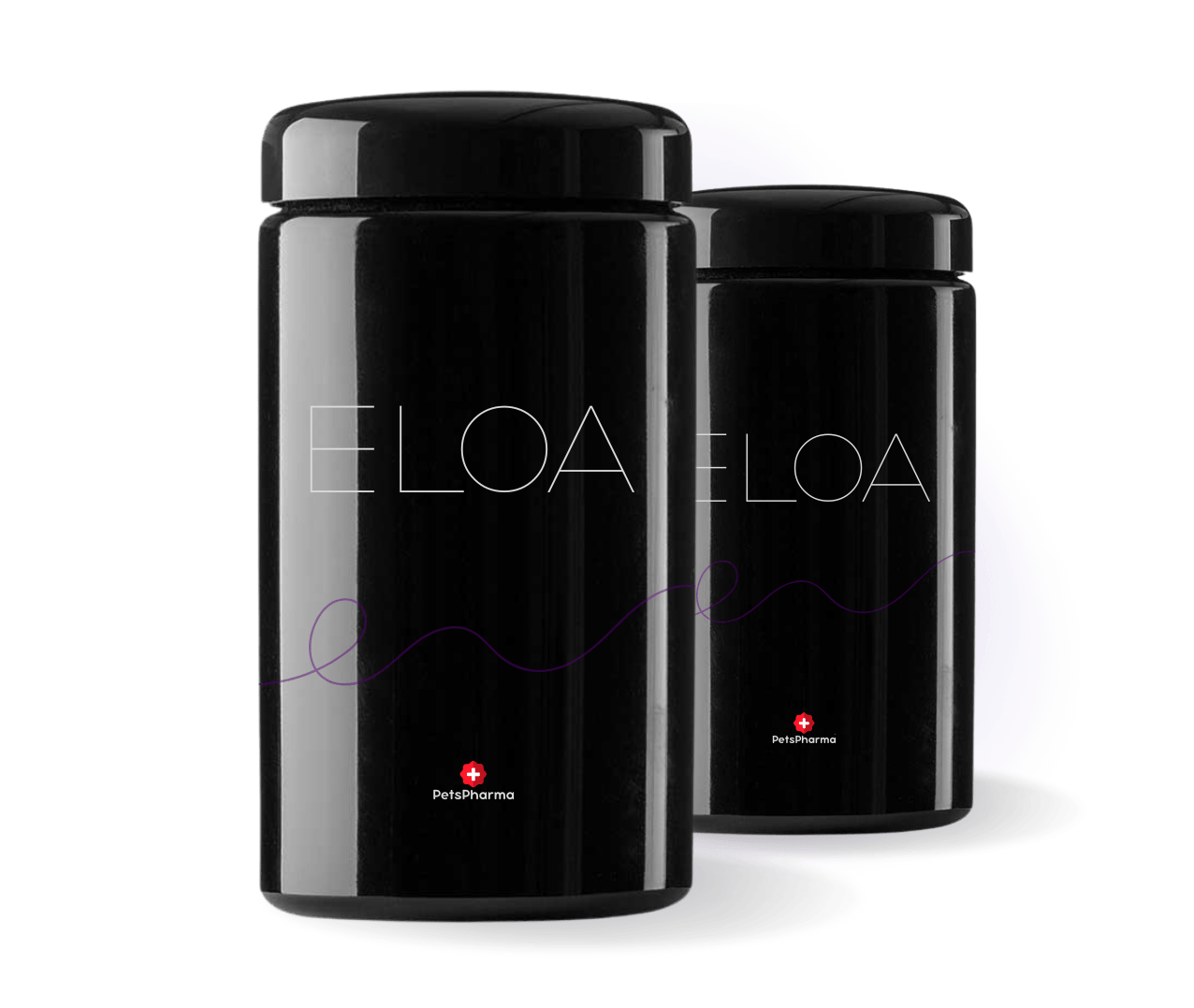
UNIQUE BIOPHOTONIC GLASS PACKAGING
- The glass of which the bottle is made acts as a natural barrier to the energy stored in the product.
- It contains special minerals that naturally increase the nutritional value and vitality of the product.
- As a result, the contents stay fresh for longer.
- The ingredients do not lose their strength, aroma, colour or texture.
- Top quality confirmed by scientific research.
Supplementation
Create a set
Effortless supplementation
Forget the hassle of administering a tablet to your dog!
Our product comes in the form of a powder capsule, which you can easily add to your pet's food. Now giving supplements to your pet will be simple and effortless.

Find out more

What for arthritis in a dog?
Recognize the symptoms: When might your dog need joint support? Joint degeneration in dogs is a problem that can significantly affect…

How do you know your dog has joint pain?
Recognize the first signs: your dog may be suffering in silence Joint diseases in dogs often develop unnoticed, and recognizing them…

What can I do to make sure my dog has healthy joints in his old age?
How does collagen affect joint health in dogs? With the health of our four-legged friends in mind, it’s worth paying special…
